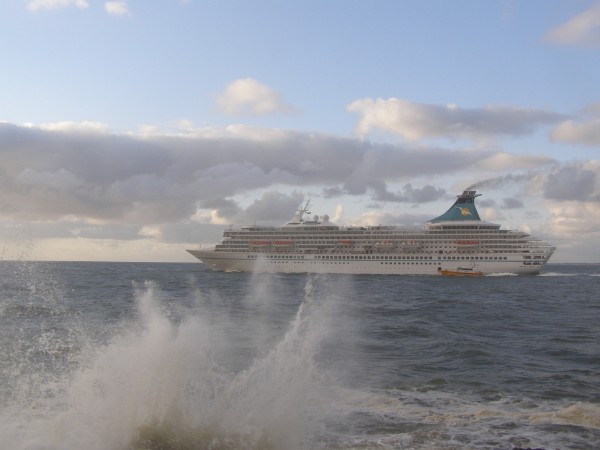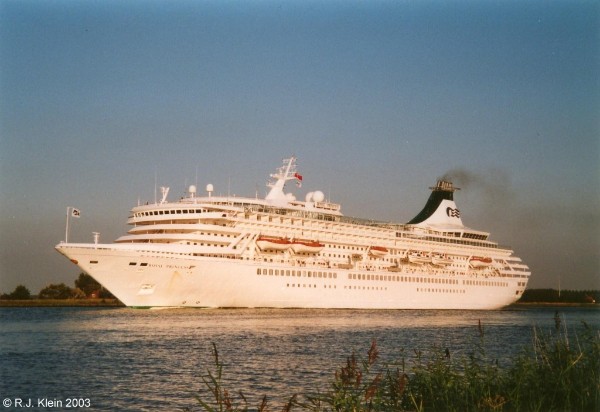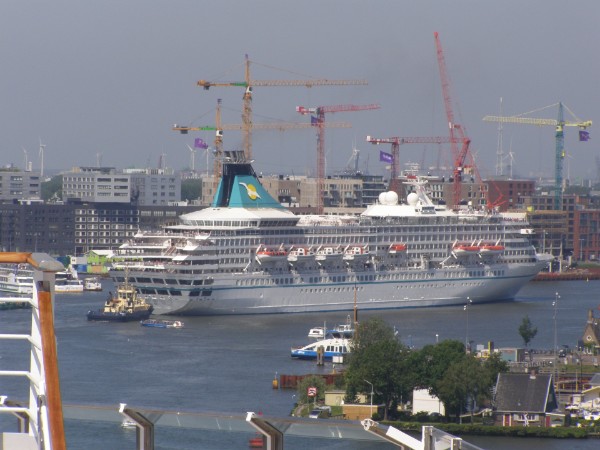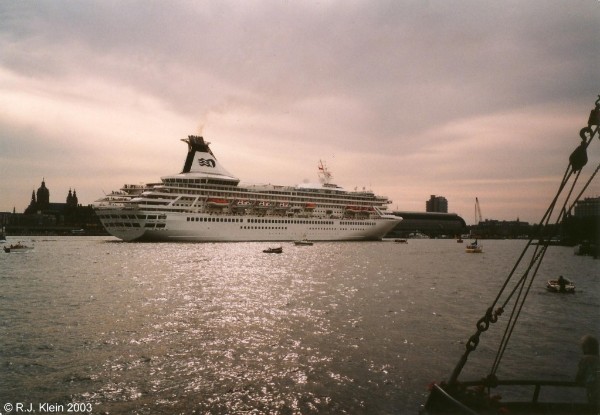Artania

Artania gets underway as seen from the IJmuiden piers at the 12th of may of 2012.
Background
Fouded in 1965 in Los Angeles by industrialist Stanley McDonald, Princess Cruises became an important player in the cruise-industry mainly after the sale to P&O in 1974. Although the cruise-industry then was foremost a way to sort out a new market for many out of date and workless oceanliners, from the late 1960's onwards a new breed of cruiseships was designed by newly created US-based companies to fit into this new role. This also started to outdate most of the old liners again that thus went to the scrapyards in a long row throughout the 1970's. The P&O Line was no exception. Even liners that had not turned twenty years of age yet were sent off to Kaohsiung at Taiwan to meet their fate as they were not able to compete with the newer cruiseships of the early 1970's like Royal Caribbean's Song Of Norway, Royal Viking Line's Royal Viking Star and Norwegian Caribbean Line's Starward. Princess Cruises was not a company that itself designed cruiseships also, they just chartered older liners from the likes of Canadian Pacific (which also inspired the name Princess for the line itself through their first 1949-built ship Princess Patricia) and the Italian Costa family. Also, only in the summermonths cruises were offered, mainly from the US westcoast to Alaska and Mexico. In 1972, the company was able to charter a newer, purpose-built cruiseship from the Norwegian company Fearnley & Eger. Only built in 1971 under the name of Island Venture, this ship was re-named Island Princess and was the first more modern cruiseship for the company. With her, also year-round cruising was undertaken and it hugely improved the company overall.
Meanwhile, the established old company P&O Lines struggled a lot to enter the new markets although they were trying with a purpose-built cruiseship they introduced in 1971 under the name of Spirit Of London. Only the name for the ship itself suggested that P&O wasn't really sure about entering the US market as they named their ship for their far-away homeport in Great Britain. Not very appealing of a name for the American customer. They did buy the ship from Norwegian Caribbean Line while on the stock and hoped that this now well-established company could provide a good ship for US cruising as they did not have the knowledge itself for this market. It was a good ship, but the P&O name wasn't known in the US at all and the British name of the ship didn't worked well either. P&O were opposite of the Cunard Line, that other old school British company, who introduced their Cunard Adventurer and Cunard Ambassador in that same year, as Cunard was already a well-known name in the US. Although their ships were proven to be not that succesfull, as P&O lacked the name, their adventure was not that profitable after all. The P&O board thus reacted and decided it was a better move if they bought a well-established American based cruiseline instead and their choice was to buy Princess Cruises in 1974. The company did well in their field and thus had already a name. So P&O kept this name intact and bought not only the line itself, but also the chartered Island Princess. In a next move to strenghten the company, P&O also bought the sistership Sea Venture and had her re-named Pacific Princess. Of course also Spirit Of London was now brought over and renamed Sun Princess. With now three modern cruiseships and a known name, P&O was way better equipped to take on the US market. Under the P&O name, they still operated the more classic 1952-built Uganda, 1959-built Oriana, and the 1960-built Canberra. These ships more-over concentrated on their traditional markets in the east and Great Britain itself. With their modern fleet, Princess did very well in the US. Stanley McDonald was also still left in charge, only he had now a way better financial position then before building out his company. But the best promotion for the company came from a totally different side.
In the mid to late 1970's, the American Broadcasting Company (ABC) was looking for a cruiseline to support a new idea of a sitcom from producer Aaron Spelling. In 1976, the movie The Love Boat was made, based on the non-fiction book by Jeraldine Saunders named Love Boats. Another two movies for television followed and they inspired Spelling in creating the series. When he approached Princess Cruises, they were kinda sceptical at first. With a title like The Love Boat, it could give the impressions that cruises were sexually orientated and the good name they had built could be shattered if they let themselves get into this new thing. But when the storylines were laid out for them, Princess agreed to have ABC filming aboard their ships. Mainly Pacific Princess and Island Princess were used and, to Princess Cruises' delight, the show became a huge success across not only the US, but many more countries as well and it aired from may 5th 1977 untill may 24th in 1986. ABC also used the name of the company and the name of the ships itself instead of re-naming them for television purposes. This of course gave a huge boost to cruising and in particular to Princess Cruises itself. Quite well needed, as cruising was becoming more popular but still looked like it was just the last breath of the former passengership industry and eager to collapse within years. In 1977, when Cunard Princess was named in New York by Cunard Line, officials of the company stated that it would probably be the very last passengership to be built and the industry would not expand any further. This seems a strange conclusion, but it was the general mood back then and indeed, it took untill 1981 when the next cruiseship was introduced. She became Carnival Cruise Line's first new ship Tropicale, after some five years without new cruiseships at all.
The Love Boat did change a lot of things while the success of the series progressed. In 1979, Norwegian Caribbean Lines made the bold move to buy the largest passengership in the world, the then laid-up 66.000-ton France of 1959 and rebuilt her into the largest cruisehip ever, the Norway. Without The Love Boat, this probably naver happened. A huge gamble, but it turned out to be a very profitable one. With her large theater, plenty of open deck and many more amenities then any other ship, Norway totally re-invented the cruise-industry. Three times the size of any other new cruiseship, she made clear that the new passengerships could be bigger then the standard 20.000-tons. She inspired more companies to re-think and order larger cruiseships in the process. One of the first of such companies to do so was of course Princess Cruises. At the same time that Norway entered service, the company ordered a large new ship themselves to continue their adventure.
Construction and general statistics
Ordered from the Wärtsilä shipyard at Helsinki as yardnumber 464, this new ship would not be as large as Norway though. Norway was of course an old-school three-class oceanliner with huge enginerooms filled with her steam-propulsion units. Built for speed and class-separation, combined with national prestige, she was in fact way larger then needed and this made her instant success and innovation quite brief as she was outdated quickly by modern tonnage. Like from of course the new Princess Cruises ship. With a tonnage measurement of 44.348 this ship still was twice as large as most ships then in service so still rated among the largest purpose-built cruiseships in history. She was also the second largest P&O-ship in history, just behind the Canberra. She was 230,61 meters long, 32,20 meters wide and her draft reached 7,80 meters. A maximum passenger capacity of 1260, on a two-per-cabin basis the number was 1188. Aboard there were also 537 crewmembers. Eight of the ships twelve decks were accessible for passengers. The ship was able to sail at a servicespeed of 22 knots and driven by two screws. Power was provided by four six-cylinder diesel engines of Pielstick-Wärtsilä design. Although she was built for the American Princess Cruises, the new ship recieved the traditional homeport of London at ther backside, flying the British flag.
At the 17th of february in 1987, the ship was floated out of her buildingdock, so not traditionally launched. In fact, she was one of the first cruiseships that wasn't. She was delivered to her company at the 30th of october of the same year and she was now known as the Royal Princess. In her, P&O combined the Princess name with their own classic and Royal British heritage and of course she bacame the flagship of the Princess Cruises fleet.

Royal Princess sailing the Northsea Canal close to Spaarnwoude at the 1st of september 2004 during her last season for Princess Cruises.
Design
A groundbreaker, that is what we can call the 1984-built Royal Princess for sure. The most expensive British cruiseship built untill then and also the largest that had been built outside of Great Britain. She was the most luxurious ship that had ever sailed for any part of P&O and also the first that was designed in a total new way. Instead of the traditional lay-out where-in the topdecks were reserved for the public spaces and the lower decks were filled with the passengercabins, this was radicly turned upside-down in the most litteral sence. To give the passengers the best views as possible and get them away from the engine-room noises, the cabins were instead placed on the higher decks and the public spaces placed below. After Royal Princess, the cruise-industry has adopted this lay-out in general because of the many advantages. This also gave the opportunity to install private balconies in the abundance as it was done. Next to that, she was the first mayor cruiseship without any inside cabins. All cabins had seaviews and none of them had portholes. All cabins that didn't have balconies recieved large windows instead. On two of her decks, the Lido and Aloha Decks, the balconies were installed. These decks were the decks above the lifeboats and although balconies were not something that had never been seen aboard oceanships, it was the first time that this many were installed.
The general appearance of Royal Princess was most pleasing. A modern cruiseship, but she didn't have a lack also of classic touches making her the perfect example of the cross-over between the old and the new breeds of cruiseliners. She has a clipperbow, a massive but good proportioned superstructure and her funnel was placed well aft to make space for large open lidodecks with a big swimmingpool in the middle. Underneath her lifeboats, there was a traditional wrap-around promenade deck of teak instead of the morden astroturf. P&O had clearly learned what their American passengers enjoyed, but also blended that in perfectly within the expectations of their British and European customers. With P&O's own Uganda out of service since the war at the Falklands in 1982 and the Oriana on the brink of being sold as a hotelship in Japan, Royal Princess needed to appeal to the classic markets in Europe as well and not only to the American markets served by Princess Cruises. Because of this, we can also say the Royal Princess was the first true ship designed with global cruiseservice in mind and the first that brought the Princess brand more recognition across the Atlantic as well. After all, The Love Boat was also becoming a global hit.
Her main public rooms are to be found on the Riviera Deck. In her Princess years these included the Princess Theater, Princess Court, the International Lounge, Riviera Club and the ships Casino. Her main dining room, the Continental Dining Room, was to be found one deck below, on the Plaza Deck. Wrapped around her funnel was a lounge also, named the Horizon Lounge that gave spectacular 360-degree views to all sides. The placement of her public rooms was in fact almost an exact copy of the placement of the rooms aboard the Island Princess and Pacific Princess, just with a slight size increase of course. This way, the repeat passengers would feel directly at home and also the Love Boat fans, who of course knew the lay-out of the true stars of the show, wouldn't be dissappointed.

Artania leaving Amsterdam at the 30th of may 2011 as seen from the decks of Costa Magica. This is during one of her first cruises for Phoenix Reisen.
Carreer
After delivery to her owners, Royal Princess set sail from Helsinki to Southampton, where she was to be named by Diana, HRH the Princess of Wales at the 15th of november in 1984. Before the ship was named by her, the Bishop of Southampton performed a blessing of the ship. Also the President of Finland, Mauno Koivisto, was present due to the fact that the ship was built in Finland of course. A few days later, at november the 19th, the ship departed for her Maiden Voyage across the Atlantic towards Miami and she was fully booked for the voyage. But during this sailing, it was discovered that the fairweather ship was a long distant daughter of all those ocean greyhounds that had made the crossing before her. She had a hard time due to high winds and large waves and so did her passengers. She was clearly not designed for trans-atlantic sailings in wintertimes!
Luckily, most of her sailings took her to Mexico and Alaska from the US westcoast in her earliest years and those sailings were way more smooth. But she wasn't limited here, of course as she had been designed to take Princess Cruises to other regions as well. In her Princess years she visited many countries and many regions, from the both America's to Europe, the Mediterranean and even Australia and the East, the traditional P&O regions.
She became a classic favorite of many and Princess Cruises grew quickly after her introduction. In 1989, P&O bought the Sitmar Line and their four-ship fleet. But the most important thing in this deal was that Sitmar at the time had three very large cruiseships on order or already building. P&O integrated the fleet in Princess Cruises operations so Princess doubled their capacity in just one year. From this deal, Star Princess came in 1989, Crown Princess in 1990 and Regal Princess in 1991. They were rated among the largest cruiseships in the world and P&O was briefly made into the largest cruise-operator in the world because of this aquisition. Immidiately, the company started a modernisation and they ordered a series of four ships to be delivered in the mid 1990's, the later Sun-class. It lead to the even larger Grand Princess that was delivered in 1998 as the largest cruiseship in the world and she was followed by a string of sisterships. Very modern liners with decks of balcony cabins and too many amenities to choose from. The introduction of larger cruiseships like Royal Princess from the mid-1980's onwards made the cruise-industry grow to new heights. What comes with that is that older ships become more out-dated by the newer ones and then natural selection comes into play and this also affected Royal Princess. Still a marvellous and popular ship, she was made out-to-date in the Princess Cruises fleet in the early 2000's but P&O did not want to loose her. As the brand P&O Cruises itself also had grown, the great liner seemed to be better in her place in the more classic fleet of her mothercompany and so at the end of 2004 she left the Princess fleet for a make-over into Artemis for P&O itself.
Artemis of course is not a traditional P&O name, but it was very appropriate for her, as it is the Roman name for the goddess Diana, name-sake to her original Godmother. In a crazy accident in Paris at the 31st of august in 1997, the Princess of Wales had been killed in a carcrash under a bridge in the French capital when her car was followed by papparazzi. It send a wave of grief around the world as she had been the most popular Royal Princess due to her approachable and down-to-earth nature. The name of Artemis was thus very fitting when this name was given to 'her' own Royal Princess again in Southampton in june of 2005. Artemis' new Godmother was Prunella Scales, an English actress who was well-known mostly through her role as Sybill Faulty in the immensely popular sitcom Faulty Towers. After the naming, the ship now made her first cruise for P&O departing Southampton for the Baltic Sea at the 17th of june in 2005. As now a P&O ship, she of course lost her British registry and she was now under the flag of Bermuda, with Hamilton becoming her new homeport.
During her service for P&O, the ship had another first as Sarah Breton was named the Master of the Ship in 2010. She was the second female cruiseship captain in the world, just after the Swedish Karin Stahre-Janson who had been appointed captain of the Monarch Of The Seas of Royal Caribbean in 2007. Breton was the first female captain of any British cruiseship though.
Below, Royal Princess is seen leaving Amsterdam on a beautifull summerevening on the 5th of september of 2003

On the 22nd of september in 2009, P&O announced that Artemis had been sold to Artania Shipping and that she would be chartered back untill the end of her planned 2011 season. She then would reach the acceptable age of 27 years. P&O Cruises, that had been bought itself by Carnival Corporation, was now growing with more large-scale cruiseships like Arcadia in 2005, Ventura in 2008 and Azura in 2010. To the dissapointment of many traditional P&O passengers, under Carnival management the company had shifted drasticly to the mainstream segment and Artemis seemed now out of place between monstrous new ships.
At the 26th of april of 2011, the quays of Southampton were filled with tears as one of the last traditional cruiseships of a formerly traditional British company arrived in the port before she was sailing off for her new German company Phoenix Reisen. Still a very popular ship, she found her home at this line, who already had picked up more classic ships like the Amadea, built as the Japanese Asuka in 1991 and their second Albatros that had been built as Royal Viking Sea in 1973. It was very sad to see a ship that had so much impact to the cruise-industry leave the British fleet, but Phoenix Reisen had proven that they were a very good company for older ships. Artemis recieved her new but traditionally sounding name of Artania for Phoenix Reisen and she recieved an also well-needed update making clear that this charter was not just meant for a few years. Phoenix Reisen seemed very excited about the ship and took her in with open arms. Dedicated to the German market now, Artania kept her populairity and recieved even a massive 71-day drydock update in 2014 at the Lloyd Werft at Bremerhaven. It makes clear that she is still going strong as an investment like this is a dedication to the future for the then 30-year old ship. She recieved many more balcony cabins, but they haven't spoiled her appearance like everyone had thought they would. It does make her more compatible in the modern cruise-age, that is a certainty. Even her engines were replaced, quite a costly operation, but those made her much more eco-friendly and will extend her life considerably.
In 2016, the ship was re-flagged to the Bahamas, recieving Nassau as her homeport. For Phoenix, she keeps sailing quite intensive worldwide cruises and under this name she now has been seen from the shores of Australi, New Zealand and the islands of Oceania to Canada and the America's. Also, of course she is a frequent guest to Germany, the rest of Northern Europe and the Mediterranean. Also Africa and the Indian continent are visited by her, showing the way Phoenix Reisen operates their classic fleet. The ships are not limited to any seven-day milkrun giving Phoenix passengers a wide array of sailings to choose from, all very different. It is a very fitting home for a ship that was designed to be a world-changer.

